So...I have my drivers, I've tried a few prototypes, and I feel like it's time to get serious and I need to choose an overall geometry. I'm new to this and could use some help narrowing down baffle approach. I would say complexity and materials are irrelevant as I have access to CNC and design experts.
One main thing I don't fully understand is mounting the drivers. Rear mounting with chamfer or round over vs front flush mounting. I guess if someone wanted to give me some Coles notes on that I would appreciate it 🙂
I'm doing 18" (SB audience bianco18sw450), up to about 80hz, then 12" (jbl123a) up to... probably 500, then wide range (sonido 096 field coil)to 8000, then a tweeter/super tweeter, probably rear firing. Or I may let the wide ranger go all the way with no tweeter, not totally sure yet.
It is active and will be using minidsp for the two woofers so I can eq as needed.
Here are some primary options as I see it...
1. Wide baffle all the way, around 20" wide and around 45" high, with gradual round over on the edges, similar to the Sonus Faber Stradivarius U frame or partial uframe for the 18".
Reasoning: the wide baffle with large round over seems to give good defraction characteristics for the higher frequency. Pretty good looking if a little large.
2. Do the midrange completely baffle-less mounted somehow above a more traditional flat, wide baffle for the woofers.
Reasoning: no baffle at all for mid-high has best defraction characteristics...? The woofers will appreciate some baffle for cancellation purposes
3. No baffles anywhere. Nothing extends beyond the drivers.
Reasoning: again, defraction characteristics and off axis for mids and highs is good. Lows have zero baffle coloration. Also zero cancellation mitigation so needs a lot of eq.
Can look pretty cool.
4. Triangle. Baffle gets progressively larger as the drivers get larger. I could imagine benefits for off axis response similar to offsetting drivers due to the fact that the angles are changing for each driver, vs a parallel+perpendicular shape of a rectangle. Can look good.
5. Separate, different shapes baffles. Sort of looking at the pap construction but using the size most suitable (determined...with edge software?) for each driver. Similar to the triangle idea but with rectangles basically, and more flexible on size since each is separate. Large round over on all angles would perhaps guide much of the wave off the baffle before it hits the next baffle/driver?
Other factors, possibilities:
I may be wrong thinking in some, most, or all of this, because I'm new and dumb...
One main thing I don't fully understand is mounting the drivers. Rear mounting with chamfer or round over vs front flush mounting. I guess if someone wanted to give me some Coles notes on that I would appreciate it 🙂
I'm doing 18" (SB audience bianco18sw450), up to about 80hz, then 12" (jbl123a) up to... probably 500, then wide range (sonido 096 field coil)to 8000, then a tweeter/super tweeter, probably rear firing. Or I may let the wide ranger go all the way with no tweeter, not totally sure yet.
It is active and will be using minidsp for the two woofers so I can eq as needed.
Here are some primary options as I see it...
1. Wide baffle all the way, around 20" wide and around 45" high, with gradual round over on the edges, similar to the Sonus Faber Stradivarius U frame or partial uframe for the 18".
Reasoning: the wide baffle with large round over seems to give good defraction characteristics for the higher frequency. Pretty good looking if a little large.
2. Do the midrange completely baffle-less mounted somehow above a more traditional flat, wide baffle for the woofers.
Reasoning: no baffle at all for mid-high has best defraction characteristics...? The woofers will appreciate some baffle for cancellation purposes
3. No baffles anywhere. Nothing extends beyond the drivers.
Reasoning: again, defraction characteristics and off axis for mids and highs is good. Lows have zero baffle coloration. Also zero cancellation mitigation so needs a lot of eq.
Can look pretty cool.
4. Triangle. Baffle gets progressively larger as the drivers get larger. I could imagine benefits for off axis response similar to offsetting drivers due to the fact that the angles are changing for each driver, vs a parallel+perpendicular shape of a rectangle. Can look good.
5. Separate, different shapes baffles. Sort of looking at the pap construction but using the size most suitable (determined...with edge software?) for each driver. Similar to the triangle idea but with rectangles basically, and more flexible on size since each is separate. Large round over on all angles would perhaps guide much of the wave off the baffle before it hits the next baffle/driver?
Other factors, possibilities:
- mount drivers in felt only, inlayed in a baffle
- rear mount with drivers just barely touching baffle to reduce vibration
I may be wrong thinking in some, most, or all of this, because I'm new and dumb...
I think all options are valid,
Since you have access to great tools you could definitely try them all and measure.
In a step by step approach, like #3, then #2, then #5, then maybe #4 or #1.
I favor nudes myself but I never tried all options, only your #1 and then #3.
My 2 cts about the 18sw450, one per side in nude might not be enough depending of your needs. I needed 2 in clamshell on the floor.
And it was fine Subless for a while
Since you have access to great tools you could definitely try them all and measure.
In a step by step approach, like #3, then #2, then #5, then maybe #4 or #1.
I favor nudes myself but I never tried all options, only your #1 and then #3.
My 2 cts about the 18sw450, one per side in nude might not be enough depending of your needs. I needed 2 in clamshell on the floor.
And it was fine Subless for a while
Would love to be able to try them all, but unfortunately the access I have is once removed - would require favours and expense. To be specific a good friend is a top tier (literally highest budget Hollywood movies ever made) physical special effects guy, so if something was theoretically possible...he could design it and have it built. But he's a busy guy.
Over time I would definitely be able to work through a few, but I'm hoping to hit a home run first try.
Over time I would definitely be able to work through a few, but I'm hoping to hit a home run first try.
More than diffraction, I'd recommend to think directivity control and synergy across the range.
Sorry if that was really what you were hinting at already.
In my teens edge diffractions was all the rage - I have since come across many constructions that don't really address it - and remain industry references.
The Stradivari certainly do look absolutely faboulous especially close up ;-)
Sorry if that was really what you were hinting at already.
In my teens edge diffractions was all the rage - I have since come across many constructions that don't really address it - and remain industry references.
The Stradivari certainly do look absolutely faboulous especially close up ;-)
When you say directivity control, I guess that's what I'm seeing as the end result of defraction...it's influence on off axis response. If there's gaps in understanding there I would be happy to be pointed to some more reading.
When it comes to synergy across the range, I guess that's not something I know how to approach...sort of feels like an experience skill. Is there some reading on that I could do?
And yeah, it's hard to not want the top end Sonus Faber looks (the illium is it, their top of the line? Damn it's beautiful in person). I could come pretty close to that I think. I have two matching slabs of 2" thick, 20"w and 58"h maple just dying to copy the Sonus Faber.
When it comes to synergy across the range, I guess that's not something I know how to approach...sort of feels like an experience skill. Is there some reading on that I could do?
And yeah, it's hard to not want the top end Sonus Faber looks (the illium is it, their top of the line? Damn it's beautiful in person). I could come pretty close to that I think. I have two matching slabs of 2" thick, 20"w and 58"h maple just dying to copy the Sonus Faber.
Personally, I found subwoofer section ( below 80 Hz) definitely needs baffle, otherwise the dipole cancellation will be too much to handle even with 18“ sub. Midrange and tweeter above 400-500 Hz should have as narrow as possible baffle or even no baffle to make the dipole peak as high as possible to control directivity to higher frequency. The lower mid section (80Hz to 400 Hz) is a grey area. If driver is small like 8“ then some baffle is ok but the shape should be something like the one in LX521. If you use 12“ driver then no baffle is my choice.
About diffraction, the baffle edge diffraction at midrange and treble is a most difficult thing to fix so it is better to get
About diffraction, the baffle edge diffraction at midrange and treble is a most difficult thing to fix so it is better to get
Last edited:
What you're saying is what my gut has been telling me...no baffle for mid and perhaps the 12" mid-woof, but as big a baffle as I can go for the 18". It kinda seems to make sense.
Am I correct in thinking that no baffle is the best cute for defraction in the mids?
Am I correct in thinking that no baffle is the best cute for defraction in the mids?
My approach would be a bit different…..I’d downfire the 18“ slot loaded ala Nelson Pass. Add side wings for bit of cancellation prevention and push the directivity a little narrower for better room integration. This will also help with overall baffle height and keeping your mid/fullrange on the seated listener ear height. The slot helps tremendously with reducing audible distortion higher up in response……you could run that 18 first order to problem………the slot cancellation will begin at the 1/4 wavelength distance of the slot depth…..at around 20” that’s roughly 180hz.
I’d use seperate baffles for the mid/FR and the super tweeter for sure…..if you wind up using a ribbon, the ultra light element will benefit tremendously from zero resonance transfer being isolated from the midbass and bass.
Start thinking in terms of matching dispersion when considering a baffle shape for the mid/FR driver. Measure your off axis responses badfle less and then start experimenting with baffle shapes and sizes to create the desired directivity as Linkwitz did with the LX521.
I’d use seperate baffles for the mid/FR and the super tweeter for sure…..if you wind up using a ribbon, the ultra light element will benefit tremendously from zero resonance transfer being isolated from the midbass and bass.
Start thinking in terms of matching dispersion when considering a baffle shape for the mid/FR driver. Measure your off axis responses badfle less and then start experimenting with baffle shapes and sizes to create the desired directivity as Linkwitz did with the LX521.
What you're saying is what my gut has been telling me...no baffle for mid and perhaps the 12" mid-woof, but as big a baffle as I can go for the 18". It kinda seems to make sense.
Am I correct in thinking that no baffle is the best cute for defraction in the mids?
It seems so in general, but before deciding anything you could test your drivers in nude to get an idea. Their design might have a positive or negative influence on the dipole behavior in the theorical bandpass their size suggests. The smaller ones pushing the peaks higher, but the smoothness of the front/rear waves interactions is still important for the crossover choice.
Charlielaub has a great paper on this specific question.
I don’t know the sonido, is it a 6x9” driver? If so it might be hard to integrate it up to 8khz well above its dipole peak.
Good source for multiway dipole design, use search engine of diyaudio.com!
https://www.diyaudio.com/community/threads/in-pursuit-of-a-20-20k-dipole-loudspeaker.331936/
"open baffle" is actually very vaque term. OBs typically have 1-2 drivers installed on a flat plate. This was most common way for eg. PA speakers with "full range field coil" drivers some 100-80 years ago. Their range was 200-3000Hz which was ok for speech and AM radio. Infinite width would be idea and all smaller baffles have "baffle loss" below corner frequency. Horns were typically used for disc players (shellac, not vinyl!)

Then closed boxes started to gain popularity in 1950s https://sdlabo.jp/archives/Closed_Box_Loudspeaker_Systems_Part_1-2.pdf
Bass reflex etc. resonant systems came during 1960-70s.
Problems with OB are many - loss of bass spl because of dipole radiation pattern and widely varying directivity above dipole peak. This make "power response" uneven which gives difficulties when speaker is in a room (not in anechoic chamber or open field). A single full-rage driver is worst scenario, added large woofer with baffle loss compensation helps a lot. More difficult challenge is to control directivity characteristics. Narrow baffle for midrange helps up to 2kHz, but above that physics of wavelength and driver construction geometry collide... small planar drivers are best. All coil-magnet tweeters have closed or obstructed back, so no backside radiation at all without an extra rearside tweeter.
Good sources for additional info
www.linkwizlab.com
https://musicanddesign.speakerdesign.net/tech.html
http://www.dipolplus.de/
https://www.diyaudio.com/community/threads/in-pursuit-of-a-20-20k-dipole-loudspeaker.331936/
"open baffle" is actually very vaque term. OBs typically have 1-2 drivers installed on a flat plate. This was most common way for eg. PA speakers with "full range field coil" drivers some 100-80 years ago. Their range was 200-3000Hz which was ok for speech and AM radio. Infinite width would be idea and all smaller baffles have "baffle loss" below corner frequency. Horns were typically used for disc players (shellac, not vinyl!)
Then closed boxes started to gain popularity in 1950s https://sdlabo.jp/archives/Closed_Box_Loudspeaker_Systems_Part_1-2.pdf
Bass reflex etc. resonant systems came during 1960-70s.
Problems with OB are many - loss of bass spl because of dipole radiation pattern and widely varying directivity above dipole peak. This make "power response" uneven which gives difficulties when speaker is in a room (not in anechoic chamber or open field). A single full-rage driver is worst scenario, added large woofer with baffle loss compensation helps a lot. More difficult challenge is to control directivity characteristics. Narrow baffle for midrange helps up to 2kHz, but above that physics of wavelength and driver construction geometry collide... small planar drivers are best. All coil-magnet tweeters have closed or obstructed back, so no backside radiation at all without an extra rearside tweeter.
Good sources for additional info
www.linkwizlab.com
https://musicanddesign.speakerdesign.net/tech.html
http://www.dipolplus.de/
Last edited:
Narrow baffle for midrange helps up to 2kHz, but above that physics of wavelength and driver construction geometry collide
And what happens after 2k?
Is this something basta can't help with due to the driver construction element? Is there a simulator that can help guide on this?
When I model my midrange in basta, with no baffle (or as small as I can draw it) the first dipole peak doesn't seem to hit until about 7k fairly far off axis (I can't really see what degree off axis in basta...if someone could tell me where to find that exactly).
I'm not unfamiliar with the general design principles of open baffle, but I am bad at math. I have read that thread and many, many more, but sometimes I think it's helpful to have a thread that's both specific and general.
I promote x because y...if you know what I mean. I read a lot of opinions mixed in with 9 pages of discussion, math, difference viewpoints, opposite conclusions...it gets to be a lot.
I'll read through that thread again to try and continue to firm up my understanding of baffle vs no baffle for mids...
I have done 180 deg measurements, but haven't saved many because they were so ugly...
A cone mid has basket, spider and magnet on the backside. They create obstruction and make all kinds of interferences, so directivity spectrogram above 2-3kHz is a mmess. Total energy is same but it is distributed very unevenly.
In my AINOgradients I first used double 3" mids and a horn electret tweeter. Frontside was ok but 80-180 bad. When I realized that I bought planar mid and a rearside dome. Then a planar tweeter too
https://www.diyaudio.com/community/threads/aino-gradient-a-collaborative-speaker-project.231353/
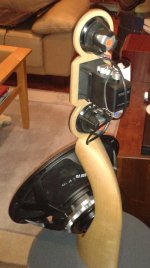
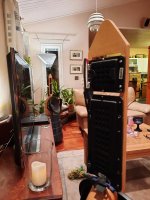
A cone mid has basket, spider and magnet on the backside. They create obstruction and make all kinds of interferences, so directivity spectrogram above 2-3kHz is a mmess. Total energy is same but it is distributed very unevenly.
In my AINOgradients I first used double 3" mids and a horn electret tweeter. Frontside was ok but 80-180 bad. When I realized that I bought planar mid and a rearside dome. Then a planar tweeter too
https://www.diyaudio.com/community/threads/aino-gradient-a-collaborative-speaker-project.231353/


So I feel like I should be seeing lower dipole peaks than I am, making me think I'm doing something wrong. I'm playing with fairly large baffle for the woofers and no baffle for the widebander.
Wasn't too worried about crossover points, focusing on off axis response mostly...
Does this look like a reasonable dipole peak at that degree off axis?

Wasn't too worried about crossover points, focusing on off axis response mostly...
Does this look like a reasonable dipole peak at that degree off axis?
I use Edge. In your pic it looks like it's closed box (no open baffle option at all?)
Gee wizz sounds like a pathway to audio hell.to many options,to many variables and choices and what are your goals in building this open baffle.what sound are you wanting to create. Also there are so many differing opinions on this forum progress will be slow if at all.
Not really its a dipole.
With no baffle , expect
the dipole peak to be rather horrible.
Since basically almost everything will be = canceled
by rear wave.
Most effective way to waste power
get a horrible response
Large baffle for woofer and mid.
Baffle has loading and like any other
dead center wont be flat.
Then add more dipole peak to that.
Same as any baffle.
large with offset drivers.
Nobody has figured out yet
most problems solved mounting right
on the wall.
Definitely for woofer.
you'll actually have bass.
standardized testing seems to be understood
by manufactures. How large , and were ideal offset is
IEC test baffle size and mounting be great place to start.
Maybe too big?
A wall is always there.
wont get smaller....
With no baffle , expect
the dipole peak to be rather horrible.
Since basically almost everything will be = canceled
by rear wave.
Most effective way to waste power
get a horrible response
Large baffle for woofer and mid.
Baffle has loading and like any other
dead center wont be flat.
Then add more dipole peak to that.
Same as any baffle.
large with offset drivers.
Nobody has figured out yet
most problems solved mounting right
on the wall.
Definitely for woofer.
you'll actually have bass.
standardized testing seems to be understood
by manufactures. How large , and were ideal offset is
IEC test baffle size and mounting be great place to start.
Maybe too big?
A wall is always there.
wont get smaller....
Last edited:
The open baffle option is selected elsewhere in basta, it's definitely set up as ob with edge defraction enabled.I use Edge. In your pic it looks like it's closed box (no open baffle option at all?)
Hi,With no baffle , expect
the dipole peak to be rather horrible.
I quote you since I've got counter example here. The post is more for the OP though, for additional data and encouragement to experiment with simulator and broaden perspective.
All problems with any driver start roughly about from driver size frequencies and up due to cone breakup, beaming, and on open baffle the backside of driver with magnet and all start breaking the pattern. In general, roughly at driver diameter wavelength the response of that driver changes towards shorter wavelengths getting more erratic, for multiple reasons. If a driver was put on larger than driver baffle, be it closed box or open baffle or anything with an edge, the frequency where erratic response starts moves even lower in frequency due to edge diffraction backwave that forms at the edge and interferes with direct sound.
Hense, logically the most fine and usable bandwidth of any driver is roughly from baffle size wavelengths down, be it closed box or open baffle. This kind of logic leads to system design where the full bandwidth 20Hz-20kHz is split into multiple different size drivers (and baffles) to avoid any single driver play into the erratic bandwidth.
If one cannot do system design so that the problematic bandwidth is avoided, then it pays to try and make the erratic behaviour as smooth as possible. This actually applies to all systems, since at least octave above crossover the output is still quite significant unless very steep filters (DSP stuff) is used.
This is 8" ideal driver on ideal open baffle from, pictures span from no baffle to progressively larger one.
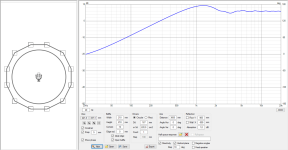
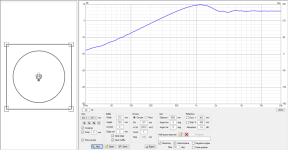
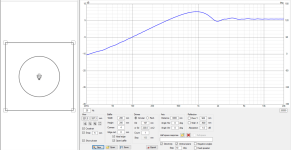
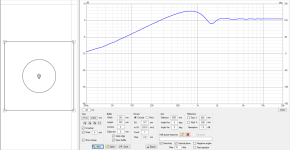
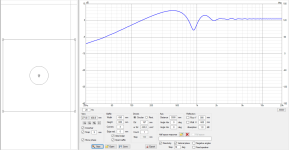
As you see from experiment like this, the usable bandwidth is roughly limited to the peak on upper end and perhaps few octaves below that. No matter what size the baffle is it's always about few octaves with open baffle due to 6db/octave drop in SPL, it only goes up or down in frequency with size of baffle. If you look the graphs it's kind of obvious the dipole peak gets worse the bigger the baffle, opposite from the quote. So, if one must use this particular size driver to as high frequency as possible, in a system, then the smallest (no) baffle looks better here in this set. If this driver must be used to as low frequency as possible, then the biggest baffle wins, but there is always only about few octaves of usable bandwidth beyond which the response gets weak on lows and erratic on highs.
If the edge is distributed by offsetting the driver and varying the shape the dipole peak gets wee bit smaller in amplitude, but is not fixed, only a sphere would fixit, or perhaps a donut in case of a dipole.
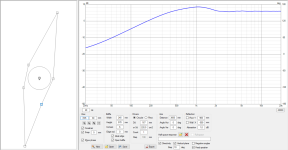
Here few offsets with the biggest baffle. On all of them the usable bandwidth is roughly similar, no matter the offset, due to edge diffraction.



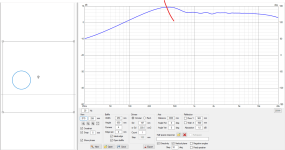
Here better view of big baffle with offset driver vs. no baffle.
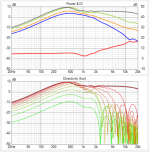
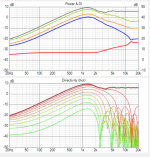
As visible, there is no good listening angle with edge diffraction beyond main dipole peak up, so in my opinion offset driver doesn't actually help anything than making the 0-axis bit better, by shifting the issues around on another axis, both cases all axis have different response. For this reason no matter the baffle size and driver position on it it's always best to low pass below the dipole peak (baffle size). The no-baffle is better option of the twi though, since it has straight DI so the main dipole hump can be EQ:d, it has better performance of the two directivity wise so that's the winner in that sense. Too high usable bandwidth? Just use bigger driver instead, again without baffle. Mind you, this ideal transducer simulation doesn't tell what a real driver with basket and magnet does, so perhaps some baffle is better than no baffle, to push the usable bandwidth below driver problems, so that they both (diffraction and driver problems) start roughly at same frequency.
So, it's the baffle edge diffraction related secondary sound source that makes response vary per direction. Bandwidth of edge diffraction secondary sound at the edge widens the larger the baffle, it's from baffle size wavelength to driver size wagelength, roughly. There is no way to escape the edge diffraction related interference with open baffle speaker other than make the edge go away completely (so big of a baffle baffle edge is further than closest early reflections of the room), or keep the edge close to transducer itself so it practically becomes one with the transducer. If there needs to be a baffle, then there is, and all it does it shifts usable bandwidth of the transducer down in frequency. Pick your poison kind of situation, like always.
Same goes to boxed speaker, except those could be made spheres to avoid edge diffraction secondary sound source forming altogether. Cone breakup and beaming and all that would still be there though, limiting the usable bandwidth.
Ok, main takeaway, since the responses seem to be good from baffle size down there is only one thing left to do here, the design 😀 the system needs to stay upright somehow and resonate as little as possible. Lack of resonance would be another win for no baffle, but it's tough to make a sturdy structure without any baffle. Perhaps hanging from strings or something, magnet mount. So how to make it then? Needs to look good, stay in budget, be manufacturable with tools and skill set, and so on.
In the end it's like any speaker, selection of compromises, choose what suits best to you, what you want to do, and how, does it need to be pretty or something, cheap? No baffle open baffle ends up having quite many drivers, which makes it costly and complex. If some issues feel no concern then one could use just one fullrange driver in huge baffle, or anything in between.
Biggest problem with edge diffraction (frequency response changing with angle, in general) I've found is that as the sound changes per direction, it feels restless and bit distracting compared to low diffraction where the response stays more the same no matter what toe-in, or head position. It helps keep the phantom center solid and your focus in the music. This is especially true with near field listening where small head movement can cause more difference in sound and it can be quite hard to find where the good spot is if sound changes no matter where the head is at. If one always listens far away the early reflections could dominate and all this reduces, it's all the same mush of sound be there edge diffraction or not. Having smooth response especially toward listening window enables freedom to tune the toe-in for good room integration, which one cannot do if the response is optimized only to one listening axis.
Most of this stuff was already posted by others. I hope this additional information with illustrations helps to gather your thoughts for your project, and then be able to reason what advice is more suitable for your project in your context and what is not. Have fun with your project!🙂
Last edited:
I wish I knew why sometimes I can quote and sometimes I can't
Amazing response. Many heart emojis.
Yes, I was a bit confused by that earlier statement as less baffle is better for dipole peak, not worse.
I think you have helped can't my thinking about offset (not worth worrying about) and baffle size for the mid (none).
Also, everything I read, the modelling I do in basta etc...keeps pointing me to baffle (I think a partial U) for the two woofers, and no baffle for the mid (and tweeters if I add some mundorf amt ob as I might).
As you point out, due to the amount of room interaction, personal preferences (for example, personally I only care about one very specific listening position) the edge defraction issues can be smaller or greater. I would guess in some circumstances they could cause a very distracting and fatiguing reflection, where in other cases it would be almost no issue. So I think the thing to do is minimize as much as possible in the design, prototype and test in room.
Fortunately I have already built some test bed baffle holders that can easily accommodate no baffle or large baffle or anything in between. I think my next test will be 20"+wings for the woofers and nothing for the mid/high.
Amazing response. Many heart emojis.
Yes, I was a bit confused by that earlier statement as less baffle is better for dipole peak, not worse.
I think you have helped can't my thinking about offset (not worth worrying about) and baffle size for the mid (none).
Also, everything I read, the modelling I do in basta etc...keeps pointing me to baffle (I think a partial U) for the two woofers, and no baffle for the mid (and tweeters if I add some mundorf amt ob as I might).
As you point out, due to the amount of room interaction, personal preferences (for example, personally I only care about one very specific listening position) the edge defraction issues can be smaller or greater. I would guess in some circumstances they could cause a very distracting and fatiguing reflection, where in other cases it would be almost no issue. So I think the thing to do is minimize as much as possible in the design, prototype and test in room.
Fortunately I have already built some test bed baffle holders that can easily accommodate no baffle or large baffle or anything in between. I think my next test will be 20"+wings for the woofers and nothing for the mid/high.
Hi, yes I try to promote thinking about context and how they might differ with each of us. Although posts can be confusing and contradicting I think there is no reason to believe anyone would lie or give bad advice on purpose, I think it all should be treated good advice. Or most of it at least. It's just that there is many many ways of doing things, experience differs, environments differ, expectations differ, and so on, so context where any advice is good varies! Context is very hard to convey over forum, unless one has been participating for years to build up some kind of profile about some members.
For example I have no open baffle speakers, all that in the post is from thinking about stuff and experimenting with simulator. Pardon not adding that to the post, I usually do. Hense, it's really important trying to think context and try to understand in which context any post is true, and in which context it's not. Or perhaps not in true/false sense but in sense how relevant anything is to you for what you are currently experiencing.
I'm confident what I wrote even though I have no OB speakers, because same stuff applies to any speaker, acoustics, transducers, so it's common stuff between all speakers in that sense. I hope it comes through that it's what I've found out, not necessarily best thing for you or anyone else. Best thing you can do is just build what feels relevant to you as it keeps you motivated and makes a good start. Then, as you get better with manufacturing and measurement, analyzing the data and what your hear and how the data correlates with perception, then you are more aware of your own context so can better relate to others and so on, and now there is a good chance to improve on things with second prototype. This stuff can take years to evolve 😀 I think you have good start, have fun!
ps. last post cannot be quoted with quote button. However, if you highlight section of text a quote button shows up.
For example I have no open baffle speakers, all that in the post is from thinking about stuff and experimenting with simulator. Pardon not adding that to the post, I usually do. Hense, it's really important trying to think context and try to understand in which context any post is true, and in which context it's not. Or perhaps not in true/false sense but in sense how relevant anything is to you for what you are currently experiencing.
I'm confident what I wrote even though I have no OB speakers, because same stuff applies to any speaker, acoustics, transducers, so it's common stuff between all speakers in that sense. I hope it comes through that it's what I've found out, not necessarily best thing for you or anyone else. Best thing you can do is just build what feels relevant to you as it keeps you motivated and makes a good start. Then, as you get better with manufacturing and measurement, analyzing the data and what your hear and how the data correlates with perception, then you are more aware of your own context so can better relate to others and so on, and now there is a good chance to improve on things with second prototype. This stuff can take years to evolve 😀 I think you have good start, have fun!
ps. last post cannot be quoted with quote button. However, if you highlight section of text a quote button shows up.
Last edited:
- Home
- Loudspeakers
- Multi-Way
- OB baffle design options